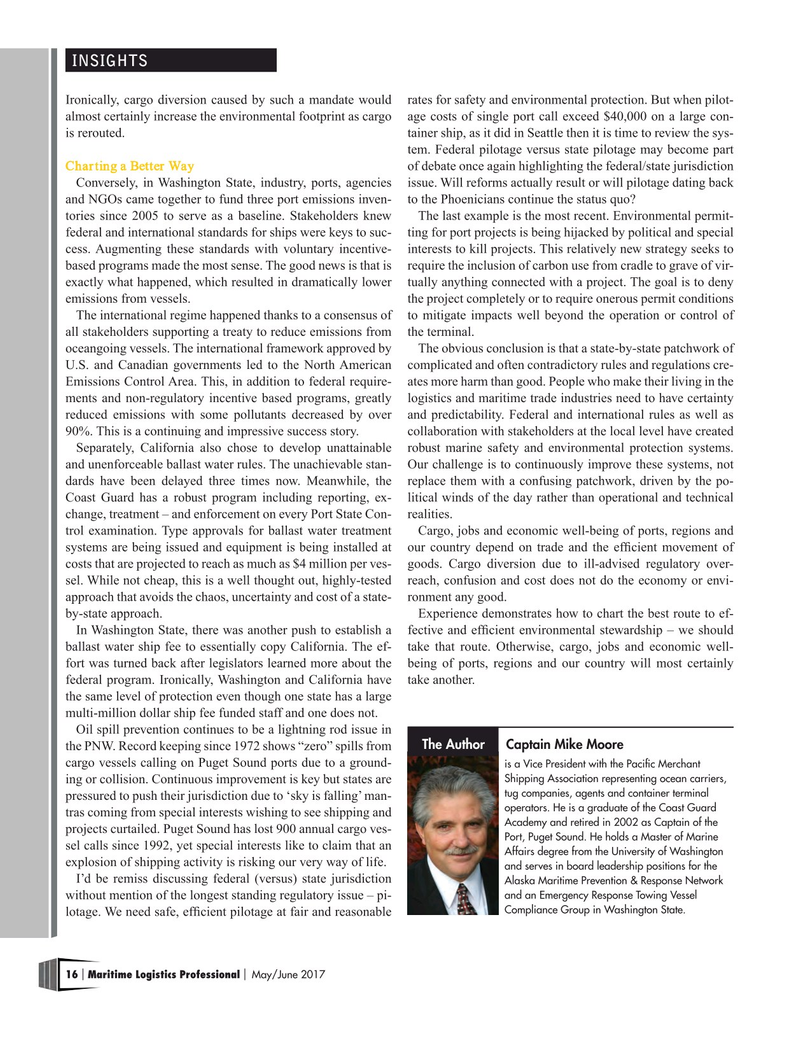
Page 16: of Maritime Logistics Professional Magazine (May/Jun 2017)
BUNKER OPERATIONS & PORTS
Read this page in Pdf, Flash or Html5 edition of May/Jun 2017 Maritime Logistics Professional Magazine
INSIGHTS
Ironically, cargo diversion caused by such a mandate would rates for safety and environmental protection. But when pilot- almost certainly increase the environmental footprint as cargo age costs of single port call exceed $40,000 on a large con- is rerouted. tainer ship, as it did in Seattle then it is time to review the sys- tem. Federal pilotage versus state pilotage may become part
Charting a Better Way of debate once again highlighting the federal/state jurisdiction
Conversely, in Washington State, industry, ports, agencies issue. Will reforms actually result or will pilotage dating back and NGOs came together to fund three port emissions inven- to the Phoenicians continue the status quo? tories since 2005 to serve as a baseline. Stakeholders knew The last example is the most recent. Environmental permit- federal and international standards for ships were keys to suc- ting for port projects is being hijacked by political and special cess. Augmenting these standards with voluntary incentive- interests to kill projects. This relatively new strategy seeks to based programs made the most sense. The good news is that is require the inclusion of carbon use from cradle to grave of vir- exactly what happened, which resulted in dramatically lower tually anything connected with a project. The goal is to deny emissions from vessels. the project completely or to require onerous permit conditions
The international regime happened thanks to a consensus of to mitigate impacts well beyond the operation or control of all stakeholders supporting a treaty to reduce emissions from the terminal. oceangoing vessels. The international framework approved by The obvious conclusion is that a state-by-state patchwork of
U.S. and Canadian governments led to the North American complicated and often contradictory rules and regulations cre-
Emissions Control Area. This, in addition to federal require- ates more harm than good. People who make their living in the ments and non-regulatory incentive based programs, greatly logistics and maritime trade industries need to have certainty reduced emissions with some pollutants decreased by over and predictability. Federal and international rules as well as 90%. This is a continuing and impressive success story. collaboration with stakeholders at the local level have created
Separately, California also chose to develop unattainable robust marine safety and environmental protection systems. and unenforceable ballast water rules. The unachievable stan- Our challenge is to continuously improve these systems, not dards have been delayed three times now. Meanwhile, the replace them with a confusing patchwork, driven by the po-
Coast Guard has a robust program including reporting, ex- litical winds of the day rather than operational and technical change, treatment – and enforcement on every Port State Con- realities. trol examination. Type approvals for ballast water treatment Cargo, jobs and economic well-being of ports, regions and systems are being issued and equipment is being installed at our country depend on trade and the effcient movement of costs that are projected to reach as much as $4 million per ves- goods. Cargo diversion due to ill-advised regulatory over- sel. While not cheap, this is a well thought out, highly-tested reach, confusion and cost does not do the economy or envi- approach that avoids the chaos, uncertainty and cost of a state- ronment any good. by-state approach. Experience demonstrates how to chart the best route to ef-
In Washington State, there was another push to establish a fective and effcient environmental stewardship – we should ballast water ship fee to essentially copy California. The ef- take that route. Otherwise, cargo, jobs and economic well- fort was turned back after legislators learned more about the being of ports, regions and our country will most certainly federal program. Ironically, Washington and California have take another. the same level of protection even though one state has a large multi-million dollar ship fee funded staff and one does not.
Oil spill prevention continues to be a lightning rod issue in
The Author the PNW. Record keeping since 1972 shows “zero” spills from Captain Mike Moore cargo vessels calling on Puget Sound ports due to a ground- is a Vice President with the Pacifc Merchant
Shipping Association representing ocean carriers, ing or collision. Continuous improvement is key but states are tug companies, agents and container terminal pressured to push their jurisdiction due to ‘sky is falling’ man- operators. He is a graduate of the Coast Guard tras coming from special interests wishing to see shipping and
Academy and retired in 2002 as Captain of the projects curtailed. Puget Sound has lost 900 annual cargo ves-
Port, Puget Sound. He holds a Master of Marine sel calls since 1992, yet special interests like to claim that an
Affairs degree from the University of Washington explosion of shipping activity is risking our very way of life. and serves in board leadership positions for the
I’d be remiss discussing federal (versus) state jurisdiction
Alaska Maritime Prevention & Response Network and an Emergency Response Towing Vessel without mention of the longest standing regulatory issue – pi-
Compliance Group in Washington State.
lotage. We need safe, effcient pilotage at fair and reasonable 16 Maritime Logistics Professional May/June 2017 | |

 15
15

 17
17
